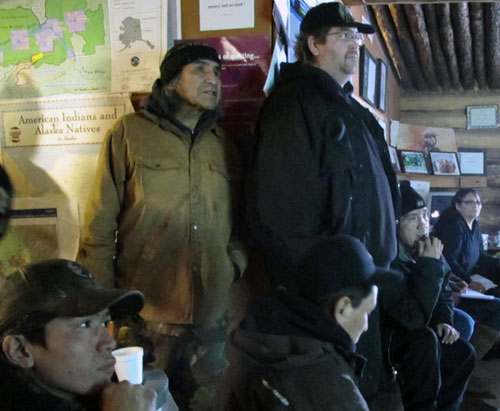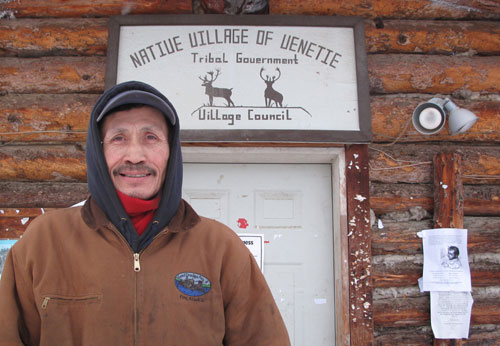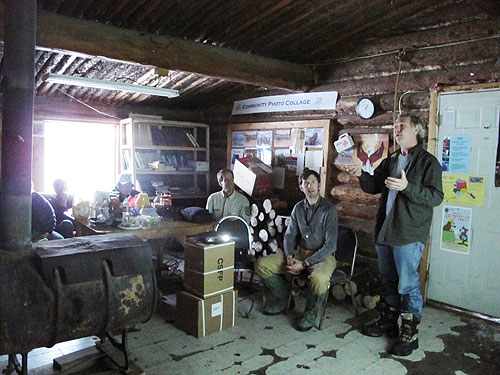
When NASA visited Venetie
February 20, 2012
The Venetie men and women in the cabin look at one another when Bundick mentions that the National Aeronautics and Space Administration is offering as much as $1,200 for the location of rocket parts. Dozens of these rocket stages remain in northern Alaska from aurora-studying missions launched during the last few decades from Poker Flat Research Range in Chatanika, about 30 miles north of Fairbanks. Burnt out rocket motors are not easy to see, especially in burned forest of the type that forms a patchwork quilt around Venetie.
Men in the village of Venetie listen to NASA officials describe a program that will reward them for coordinates of rocket parts that have landed on their tribal lands over the years. “The end of a burned tree stump, that’s what it looks like from above,” Bundick says. “Looking for these rocket parts is like looking for a needle in a haystack.” “Yes it is, says Venetie’s Ernest Erick, looking at a map of possible impact zones north and west of the village. “That’s a lot of country.” Erick, a resident of this settlement of less than 200 people, stated his village’s interests in an afternoon meeting between officials of NASA, Poker Flat Research Range and the U.S. Fish and Wildlife Service. For the three NASA researchers, this is their first winter trip to an Alaska village. One experience the Virginia residents might not forget is their ride from airstrip to village school in the back of a pickup truck when the ambient air temperature was minus 35 degrees Fahrenheit. Their mission is to spread the word of NASA’s “Clean Range Policy” initiated in 2011. The agency will pay $1,200 for location data on rocket motors that have not been reported before. There is a $500 reward for nose cones, doors, payloads and smaller rocket pieces.
Venetie resident Ernest Erick, who attended a meeting with NASA officials in the small village north of the Arctic Circle.
The attempt to retrieve rocket parts old and new (Poker Flat has one launch scheduled this spring) is in part inspired by an Environmental Impact Statement now being written. That document, which will be available for anyone to review once it is drafted, will decide the fate of continuing the NASA Sounding Rocket Program at Poker Flat, managed by the Geophysical Institute and owned by the University of Alaska. Some rocket parts, such as payloads attached to colorful parachutes, are easy to recover. Rocket motors that penetrate the ground “like lawn darts” after they burn are more difficult to find on recovery flights that occur from Poker Flat after each launch. For years, the Geophysical Institute has paid the tribal governments of Venetie and Arctic Village for the right to launch rockets from Poker Flat, parts of which may arc to the ground on their expansive lands north of the Arctic Circle. “You’re an essential partner here,” Mark Bertram, a biologist for Yukon Flats National Wildlife Refuge who traveled north from Fairbanks with the NASA people, tells the nine Venetie men and three women gathered in the cabin.
NASA’s Tripp Ransone speaks with Venetie residents in the Village Council office. To his right are NASA’s Josh Bundick and Mark Bertram of the U.S. Fish and Wildlife Service.
“We need to see an increase (in the payment for the right to use Venetie lands),” he says. “We’re not big oil people here. We’re friends of the Earth.” “I can come back and work on that, at your convenience,” says Kathe Rich, Operations Controller at Poker Flat Research Range. Rich, the point person in NASA’s rewards program, has already made payments to several people who have given her valid coordinates to rocket parts no one reported before. As the daylight wanes outside the big window in the village council office, the NASA representatives show their last PowerPoint slide, and the villagers clean their plates of fruit and other snacks carried northward by the visitors. Cold air curls into the room as people head outside to the rest of their afternoons on a late winter day. “We want to have a clean range,” Bundick says. “Now, any rocket that we launch, we want to bring it back home.”
This column is provided as a public service by the Geophysical Institute, University of Alaska Fairbanks, in cooperation with the UAF research community.
E-mail your news &
photos to editor@sitnews.us
|
||


